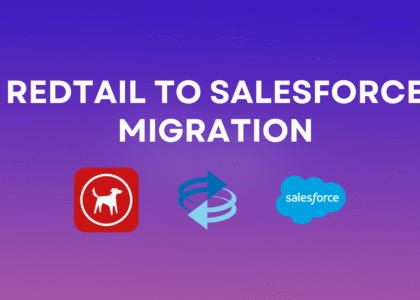In today’s fast-paced financial services landscape, customer relationship management (CRM) systems are critical to streamline operations, improve client engagement, and drive business growth. Wealthbox has been a popular CRM among financial advisors due to its simplicity and user-friendly interface. However, as businesses grow, many firms find that Wealthbox’s limited functionality and scalability may not fully meet their evolving needs. Salesforce, with its robust ecosystem and customizability, emerges as an ideal solution. This blog explores everything you need to know about Wealthbox to Salesforce migration, including benefits, challenges, migration strategies, and best practices.
Understanding Wealthbox and Salesforce
Before diving into the migration process, it is essential to understand what Wealthbox and Salesforce offer.
What is Wealthbox?
Wealthbox is a cloud-based CRM designed specifically for financial advisors and wealth management firms. It focuses on simplicity, ease of use, and workflow automation for client management. Key features include:
-
Contact and account management
-
Task and calendar integration
-
Email tracking
-
Workflow automation
-
Notes and communication tracking
While Wealthbox is efficient for smaller teams, it has limitations in advanced reporting, custom workflows, and integration with other financial tools.
What is Salesforce?
Salesforce is a globally recognized CRM platform that caters to businesses of all sizes. Salesforce offers a highly customizable and scalable solution, making it suitable for financial advisory firms aiming for growth and advanced automation. Key Salesforce features include:
-
Advanced lead and opportunity management
-
Custom workflows and automation through Salesforce Flow
-
Comprehensive analytics and reporting
-
Integration with third-party applications
-
Highly secure data storage
-
AI-powered insights via Salesforce Einstein
For financial firms, Salesforce Financial Services Cloud provides specialized features for managing households, clients, and accounts.
Why Migrate from Wealthbox to Salesforce?
Migration from Wealthbox to Salesforce is increasingly common among financial advisory firms. Some of the main reasons include:
-
Scalability: Wealthbox works well for small teams, but as businesses grow, the need for scalable CRM with custom modules becomes critical. Salesforce can accommodate teams of any size and complexity.
-
Advanced Automation: Salesforce allows automation of workflows, reminders, client segmentation, and follow-ups in a highly customizable manner, reducing manual effort.
-
Better Analytics: Salesforce provides robust reporting and analytics tools, offering insights into client engagement, portfolio performance, and sales effectiveness.
-
Integration Capabilities: Salesforce integrates seamlessly with financial planning tools, marketing platforms, and other software essential for wealth management.
-
Customization: From custom fields and objects to automation and dashboards, Salesforce can be tailored to meet unique business processes, unlike Wealthbox’s more rigid structure.
-
Enhanced Security: Salesforce offers enterprise-grade security and compliance features, ensuring sensitive financial data is protected.
Challenges in Wealthbox to Salesforce Migration
While migration can provide significant benefits, it is not without challenges. Financial firms must be prepared to tackle the following:
-
Data Mapping Complexity: Wealthbox stores data in a certain structure. Migrating to Salesforce requires careful mapping of contacts, accounts, tasks, notes, and other records to Salesforce objects.
-
Data Quality Issues: Duplicate records, incomplete information, and inconsistent data formats can complicate the migration process.
-
Customization Differences: Wealthbox has limited customization, whereas Salesforce allows extensive customization. Aligning existing processes with Salesforce workflows requires careful planning.
-
Downtime Risks: Migration can disrupt daily operations if not managed correctly.
-
User Adoption: Salesforce has a steeper learning curve compared to Wealthbox. Training users to efficiently navigate the new CRM is crucial.
-
Regulatory Compliance: Financial advisors must ensure that sensitive client data is handled according to regulations during migration.
Step-by-Step Wealthbox to Salesforce Migration Process
Successful migration requires meticulous planning and execution. Here is a structured approach:
Step 1: Assess Your Current Wealthbox Setup
-
Review all modules, including contacts, accounts, tasks, notes, and workflows.
-
Identify essential data and processes that must be migrated.
-
Determine custom requirements for Salesforce (fields, objects, workflows).
Step 2: Data Cleanup
-
Remove duplicates, incomplete records, and outdated information.
-
Standardize data formats for consistency.
-
Validate email addresses, phone numbers, and client IDs.
Step 3: Choose a Salesforce Edition
-
Select a Salesforce edition suitable for your firm, typically Salesforce Financial Services Cloud.
-
Decide on additional tools or apps needed for integration (e.g., DocuSign, marketing automation, financial planning tools).
Step 4: Data Mapping and Migration Planning
-
Map Wealthbox fields to Salesforce objects. For example:
-
Contacts → Contacts
-
Accounts → Accounts or Households
-
Tasks → Tasks/Activities
-
Notes → Notes/Attachments
-
-
Determine data migration tools, such as Salesforce Data Loader, third-party ETL tools, or migration services.
Step 5: Migration Testing
-
Perform a test migration with a subset of data.
-
Check for accuracy, completeness, and formatting issues.
-
Validate relationships between objects (e.g., accounts linked to contacts).
Step 6: Execute Full Migration
-
Migrate all validated data into Salesforce.
-
Monitor for errors and resolve them promptly.
-
Ensure that automation, workflows, and dashboards are properly configured.
Step 7: User Training and Adoption
-
Train team members on Salesforce features and workflows.
-
Provide documentation and best practices.
-
Encourage users to report issues and feedback.
Step 8: Post-Migration Review
-
Verify that all data is migrated accurately.
-
Check integrations with financial planning, marketing, and other tools.
-
Evaluate KPIs to ensure the system supports business goals.
Best Practices for a Smooth Migration
To minimize risks and ensure success, follow these best practices:
-
Engage a Salesforce Consultant: Working with a certified Salesforce migration expert ensures a smooth transition.
-
Plan for Data Quality: Clean and standardize data before migration.
-
Phased Migration: Consider migrating in phases to avoid disruption.
-
Backup Data: Always backup Wealthbox data before starting migration.
-
User-Centric Training: Focus on features that improve user efficiency and adoption.
-
Audit and Monitor: Regularly audit migrated data and monitor workflows post-migration.
-
Leverage Automation: Utilize Salesforce Flow and Process Builder to automate repetitive tasks.
Tools and Solutions for Wealthbox to Salesforce Migration
Several tools can simplify migration:
-
Salesforce Data Loader: Native Salesforce tool for bulk data import/export.
-
Skyvia: Cloud-based data integration platform that supports CRM migration.
-
Talend: Advanced ETL platform for complex data transformations.
-
Data2CRM: Specialized service for CRM migration.
Using these tools, firms can automate data transfer, ensure data integrity, and reduce manual effort.
Benefits of Migrating to Salesforce
By migrating to Salesforce, financial advisory firms can achieve:
-
Improved Client Relationships: Better tracking and engagement with clients through advanced CRM tools.
-
Operational Efficiency: Automated workflows reduce manual effort and errors.
-
Enhanced Reporting: Insightful dashboards and reports enable informed business decisions.
-
Scalability: Easily accommodate growing teams and client portfolios.
-
Regulatory Compliance: Enterprise-grade security and audit trails for sensitive data.
Real-World Example
Consider a mid-sized wealth advisory firm managing 5,000 clients in Wealthbox. They struggled with reporting and integration with financial planning software. Migrating to Salesforce Financial Services Cloud allowed them to:
-
Consolidate client data into households and accounts
-
Automate reminders and follow-ups
-
Integrate with portfolio management and email marketing tools
-
Generate advanced analytics dashboards
-
Improve user adoption with customized training
Within six months, the firm reported a 35% increase in operational efficiency and improved client satisfaction scores.
Conclusion
Migrating from Wealthbox to Salesforce is a strategic move for financial advisory firms aiming for growth, efficiency, and improved client engagement. While the process requires careful planning, data cleanup, and user training, the long-term benefits far outweigh the challenges. Salesforce’s robust ecosystem, advanced automation, and analytics capabilities empower financial advisors to focus on what matters most—building meaningful relationships with clients.






